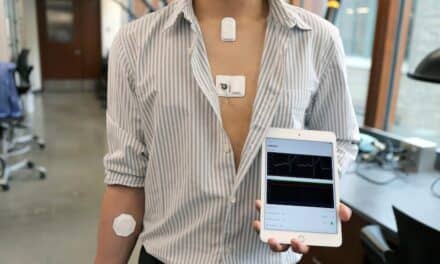Early warning signs of diseases caused by dysfunctional levels of stress hormones could be spotted more easily thanks to a new wearable device developed by endocrine researchers. This is the first time it has been possible to measure changes to people’s stress hormones as they go about normal daily activities, across both day and night. The new collaborative research led by the University of Bristol, University of Birmingham, and University of Bergen has the potential to revolutionize how diseases of the stress hormone system are diagnosed and treated.
The technology, funded by an EU Horizon 2020 project grant and published in Science Translational Medicine, shows how tracking adrenal steroid levels at high resolution and over an extended time period can provide better information about how hormone levels change across daily (circadian) and faster (ultradian) time periods.
Stress hormones such as the hormone cortisol are crucial for life. Disturbance of their rhythms due to disease and lifestyle factors are related to diseases like depression, heart disease, obesity, diabetes, and even critical illness. However, until now scientists haven’t been able to define what normal rhythmicity looks like in healthy daily life.
A major problem has been that understanding the meaning of a hormone test is very difficult or impossible if only a single time point is taken, since this fails to consider hormonal rhythms. This in turn leads to diagnostic delay and missed opportunities for treatment intervention. Previously the only way to build an accurate picture has been to take multiple samples of blood during admission to a hospital or research unit, which is not only time consuming and inconvenient, but also stressful.
U-RHYTHM has been developed by scientists from the University of Bristol, designed by the company Designworks Windsor, and available through the University of Bristol spin-out company Dynamic Therapeutics. The wearable device is worn around the waist and painlessly and automatically samples from beneath the skin every 20 minutes, without the need to collect blood. Importantly, the method allows sampling during sleep, work, and other daily life activities for up to 72 hours in a single session.
The study demonstrates the potential for the U-RHYTHM device, analyzing samples from 214 healthy volunteers over 24 hours. Using data across multiple timepoints in that period, the team were able to create adrenal hormone profiles of healthy people in real-life conditions.
Mathematicians from the University of Birmingham’s Centre for Systems Modelling and Quantitative Biomedicine used these data to develop a new class of “dynamic markers” to better understand how a healthy hormonal profile should look like depending on an individual’s sex, age, body mass index, as well as other characteristics.
These findings show what healthy hormonal rhythms look like in the population, in real world settings, and could form a baseline for new, better ways to diagnose endocrine conditions at a much earlier stage.
“Our results represent a paradigm shift in the understanding of how the stress hormone system works in healthy people,” says Dr Thomas Upton, Clinical Research Fellow in Automated Sampling at the University of Bristol and lead endocrinologist in the study. “The information we have gathered forms an entirely new reference range which has the potential to revolutionize how diseases of the stress hormone system are diagnosed and treated.”
Dr Eder Zavala, Assistant Professor in Mathematics at the University of Birmingham and lead mathematician in the study, adds, “This is a fascinating new technology that is enabling us to make new discoveries about how hormonal regulation works, while the mathematical analysis is enabling us to generate new ideas about precision diagnosis and design personalized medicine interventions that better support patients.”
Stafford Lightman, Professor of Medicine at Bristol Medical School: Translational Health Sciences (THS) and a co-author on the study, explains, “Our results provide significant new insights into how the stress hormone system works in healthy people, and emphasizes the importance of measuring change, not just sampling at single points. It also highlights the importance of measuring hormones during sleep, which has previously been impossible outside of a hospital.
“The ability to measure the dynamics of hormone secretion across the day and night in patients in their own home will not only improve our ability to accurately diagnose any abnormality in hormone secretion without the need for complex inpatient investigations, but the whole diagnostic procedure can be performed from primary care and linked to newly available diagnostic algorithms. This will not only provide good, personalized medicine, but will also allow the patient to follow their own hormone profiles during diagnosis and therapy and empower better patient-to-doctor discussions.”
Featured image: The U-RHYTHM wearable device. Photo: Designworks Windsor





